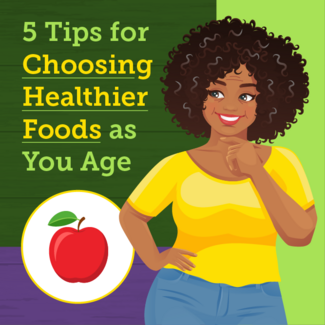Healthy Meal Planning: Tips for Older Adults
Eating healthfully and having an active lifestyle can support healthy aging. Use the resources below to learn about different patterns of healthy eating and ways to create a nutritious meal plan.
Older adults' unique nutrition needs
Simple adjustments can go a long way toward building a healthier eating pattern. Follow these tips to get the most out of foods and beverages while meeting your nutrient needs and reducing the risk of disease:
- Enjoy a variety of foods from each food group to help reduce the risk of developing diseases such as high blood pressure, diabetes, and heart disease. Choose foods with little to no added sugar, saturated fats, and sodium.
- To get enough protein throughout the day and maintain muscle, try adding seafood, dairy, or fortified soy products along with beans, peas, and lentils to your meals. Learn more about protein and other important nutrients.
- Add sliced or chopped fruits and vegetables to meals and snacks. Look for pre-cut varieties if slicing and chopping are a challenge for you.
- Try foods fortified with vitamin B12, such as some cereals, or talk to your doctor about taking a B12 supplement. Learn more about key vitamins and minerals.
- Reduce sodium intake by seasoning foods with herbs and citrus such as lemon juice.
- Drink plenty of water throughout the day to help stay hydrated and aid in the digestion of food and absorption of nutrients. Avoid sugary drinks.
It can be hard for some people to follow through on smart food choices. Read about common roadblocks and how to overcome them and check out the USDA’s tips for older adults.
Meal planning
Answering the question “what should I eat?” doesn’t need to leave you feeling baffled and frustrated. In fact, when you have the right information and motivation, you can feel good about making healthy choices. Use these tips to plan healthy and delicious meals:
- Plan in advance. Meal planning takes the guesswork out of eating and can help ensure you eat a variety of nutritious foods throughout the day.
- Find budget-friendly foods. Create a shopping list in advance to help stick to a budget and follow these SNAP-friendly recipes.
- Consider preparation time. Some meals can be made in as little as five minutes. If you love cooking, or if you’re preparing a meal with or for friends or family, you may want to try something a little more challenging.
- Keep calories in mind. The number of calories people need each day varies by individual. Always discuss your weight and fitness goals with your health care provider before making big changes. Read about calorie goals and healthy food swaps.
When you create your shopping list, don’t forget nutritious basics such as fresh fruits and vegetables and whole-grain bread. This sample shopping list (PDF, 108 KB) includes a variety of healthy foods you may want to have in your kitchen.
Sample menus
Here are some meal options for breakfast, lunch, dinner, and snacks, including links to recipes as well as simpler choices that can be put together without a recipe.
| Breakfast | Lunch |
|---|---|
|
|
| Dinner | Snack |
|
|
You may also be interested in
- Learning about food and beverage labels
- Exploring different food groups
- View this infographic on how to make mealtimes easier for people with Alzheimer's disease
Sign up for e-alerts about healthy aging
For more information on healthy eating
USDA MyPlate
703-305-2060
www.myplate.gov
USDA Center for Nutrition Policy and Promotion
703-305-7600
www.fns.usda.gov/cnpp
USDA Food and Nutrition Information Center
National Agricultural Library
301-504-5755
fnic@ars.usda.gov
www.nal.usda.gov/fnic
USDA Food and Nutrition Service
Supplemental Nutrition Assistance Program (SNAP)
SNAP State Directory of Resources
www.fns.usda.gov/snap/state-directory
U.S. Department of Agriculture
202-720-2791
www.usda.gov
This content is provided by the NIH National Institute on Aging (NIA). NIA scientists and other experts review this content to ensure it is accurate and up to date.
Content reviewed:
November 23, 2021




